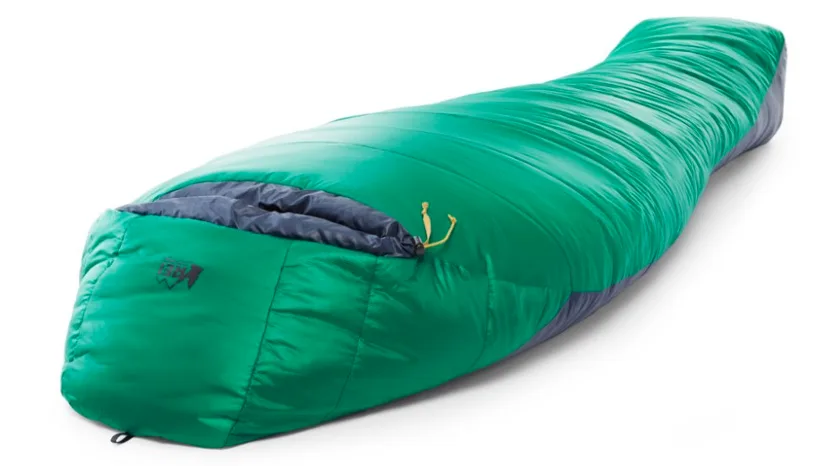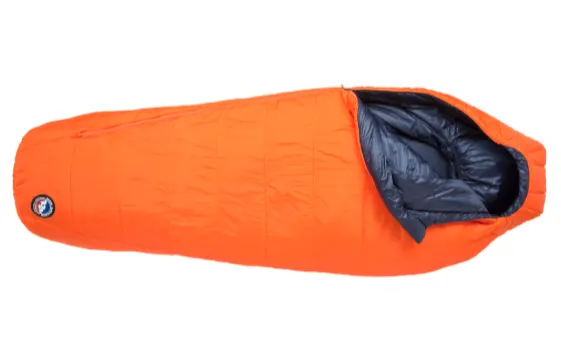Up to 50% Clearance Clothing & Footwear + Extra 25% Off REI Outlet.
When it’s time to shop for a new sleeping bag, there are two main considerations for selecting the right bag for you: type of insulation (read about why we think you should avoid down) and temperature rating. Every bag has the latter, usually right in the name of the bag, but those numbers may not mean what you think they mean. In fact, they could be up to 20º off, meaning you could be spending a very chilly night in the woods if you’re not careful! So allow us to enlighten you. Right here, right now, we’ll break down sleeping bag temperature ratings and help you find the right sleeping bag for you by explaining what the temperature ratings actually mean. That way, you can sleep comfortably in the great outdoors any time of year.

Understanding Sleeping Bag Temperature Ratings
In the name and description of every sleeping bag on the market, there will be a number, like in the REI Zephyr 20 or Marmot Trestles Elite Eco 30. Most bags–at least for those of us not attempting to summit Everest–will be rated between 0º-55º. Simple enough, right? You’d likely want a 55º bag for warmer summer temperatures when you won’t need as much insulation to keep your tootsies warms and a 15º bag for cooler fall or winter nights, right? Maybe. But it’s not always so simple. Basically, that temperature rating that first catches your eye may not mean what you think it means.
For example, If you look at the temperature ratings for a bag with a standard EN rating, there will be 2 numbers: a “comfort limit” and a “lower limit”. The lower limit will probably match the number in the name of the bag. In a unisex bag, The lower limit is the coldest temperature at which a man will likely feel comfortable. But the “comfort limit” is the lowest temp at which a woman will likely sleep comfortably. And that comfort rating is usually 10º-20º higher than the lower limit, (meaning a unisex bag rated as a 15º bag will probably only be comfortable down to 27º for a woman)! Which explains why Josh feels cozy in his 20º bag almost down to 20º while I start shivering in the same exact bag at 35º or 40º…
It also explains why women’s specific bags from the exact same brand are both bigger and heavier than the same men’s model–because to offer the same temperature rating, they do, in fact, require more insulation!

It’s also important to keep in mind that the labeled temperature rating on your bag isn’t usually the optimal performance temp of the bag; it’s where things start getting a little too chilly for comfort. Meaning if 30º is the lower limit, by the time temps actually reach 30º, you could be quite chilly. So if you regularly camp in 30º temps, maybe opt for a bag that’s rated for colder weather to keep you as comfortable as possible.
I say usually because to make things even more confusing, some bags (mostly women’s bags from REI), rate the bag with the comfort rating, not the lower limit rating. Basically, you just have to dig into the description and specs to find out if that’s the case.


To further complicate things, not all outdoor gear manufacturers use the same rating system. Big Agnes, for example, uses their own independent rating system; you simply have to go by the stated temp in the name of the bag (the Sunbeam 15º, for example, has a lower limit rating of 15º) and trust that it’s accurate as it wasn’t third-party certified. Marmot, on the other hand, only publishes one temperature, which customers have to assume is the lower limit).
To further further complicate things, these numbers don’t account for what type of tent or sleeping pad you’ll be using (some sleeping pads, like insulated pads (which we wrote about in this post) or closed-cell foam pads, will keep you warmer than many inflatable pads) or how many layers you have on, and they certainly don’t consider whether you have a fast metabolism or less built-in insulation (aka fat) and sleep colder than your same-gendered camping buddies. So basically, sleeping bag temperature ratings are more or less just a rough estimate. Even Big Agnes states that temperature ratings are highly subjective! Plus, a sleeping bag’s temp rating is based on a person who is wearing a base layer and socks and is using an insulated pad with an R-value of approximately 5.5 (which usually consists of an insulated pad stacked with a closed cell foam pad).

That said, now that you have a bit of insider knowledge as to how the whole convoluted rating system works, hopefully you can pick a sleeping bag with confidence. And also, you know, not freeze to death on your next camping trip and spend the entire night wondering why…
Did we help demystify sleeping bag temperature ratings for you? Did you learn about the convoluted system the hard way? Let us know in the comments! Want a list of synthetic sleeping bags organized by temperature rating? Check out this post. And then get out there and spend a few nights sleeping under the stars. Wander on!
•
This post contains affiliate links, which means we may receive a small percentage of any sales that result for you click-clicking on any links. Thanks for helping support Terradrift!
Alisha is a freelance outdoor journalist and photographer based in Ogden, UT. She loves backpacking, hiking, mountain biking, kayaking and snowboarding (even though she’s terrible at it). She’s also pretty sure she’s addicted to coffee. alishamcdarris.com
